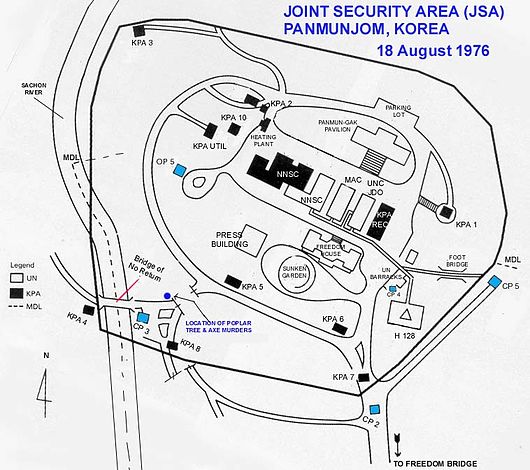A Tree Falls in North Korea
North Korea and South Korea, to say the least, aren’t all that friendly. The Korean War ended with an armistice — not a peace agreement — which, per the document, aimed to create a cease-fire “until a final peaceful settlement is achieved.” To date, no such agreement has been reached, and the two sides are often violently at odds. Since the close of the war, there have been a few attempts by one to overtake the other — bombings, shootouts, and attempted coups all make the nations’ collective history. And because of this, in 1976, 813 men were sent on a special mission — to cut down a tree.

Pictured above is a map of the Joint Security Area (JSA), part of the Demilitarized Zone (DMZ) separating North and South Korea. It is the only part of the DMZ where the two sides meet, and is often called the “Truce Village” because of that distinction. The map depicts the general layout of the JSA as of 1976. Toward the bottom left of the encircled area is the Bridge of No Return — this was the only formal way to cross from North Korea into the JSA and ultimately, into South Korea. You’ll note a blue dot near the Bridge of No Return; that was where a 100 foot (30m) tall poplar tree once stood.
The tree was problematic for the United Nations Command in the area. The Bridge of No Return had to be watched at all times, and soldiers were therefore always manning a checkpoint on the JSA side of it. That checkpoint, CP3 on the map above, was a dangerous place to work, as North Korean forces would occasionally try and capture the men stationed there and drag them across the bridge. In part to account for this, the UN staffed an observation post, seen above as OP5, which kept watch on CP3 — usually. The problem was the tree; it obstructed the view between OP5 and CP3 and therefore needed regular trimming. On August 18, 1978, eleven men — some American, some South Korean — escorted a five-man trimming crew to the site.
At first, the North Korean guard from across the bridge watched without concern, but that changed about 15 minutes into the pruning. The North Korean lieutenant in charge of the forces on his side of the DMZ demanded that the South Korean team stop immediately — he claimed that North Korean leader Kim Il-Sung had, himself, planted the tree in question. But the trimming crew did not heed the North Korean’s warnings until it was too late. North Korean soldiers came over the bridge, armed with crowbars. The workers fled, dropping their axes in the process. The North Koreans took the axes and, in the end, two of the Americans were axed to death. The tree remained.
The North Korean aggression was, understandably, unacceptable to the Americans, but then-President Gerald Ford wanted to limit the chance of throwing the region into open war. The solution: kill the tree — with a massive show of force. Not only would that demonstrate the American’s military superiority, but it would remove the obstruction once and for all. (Plus, it would probably upset the North Korean lieutenant who wanted the tree left alone.) The operation involved 27 helicopters, a handful of bombers, a few dozen military ground vehicles, an off-shore aircraft carrier, sixty-four South Korean soldiers apparently trained in martial arts (and armed with rifles), and sixty other troops armed with pistols — all in support of two eight-man engineering teams equipped with chainsaws, per Wikipedia. Forty-two minutes later, the tree came down, and there was nothing the North Koreans could dare do about it — even though nearly 200 of their own men, armed with machine guns, were watching the entire time.
Bonus Fact: Both North and South Korea have armed guards stationed in the JSA at all times. The South Korean ones are required to have mastered either Tae Kwon Do or Judo, if not both, and put this to use as part of their duties. How? Wikipedia explains: the guards “stand in a modified Tae Kwon Do stance with solid facial expressions, clenched fists, and sunglasses, which is meant to intimidate the North Koreans.”
From the Archives: The Isolated Tree: An impossible, but somehow true story, which defies explanation without giving it away.
Related: Quote the package: “Grow a tree!”
